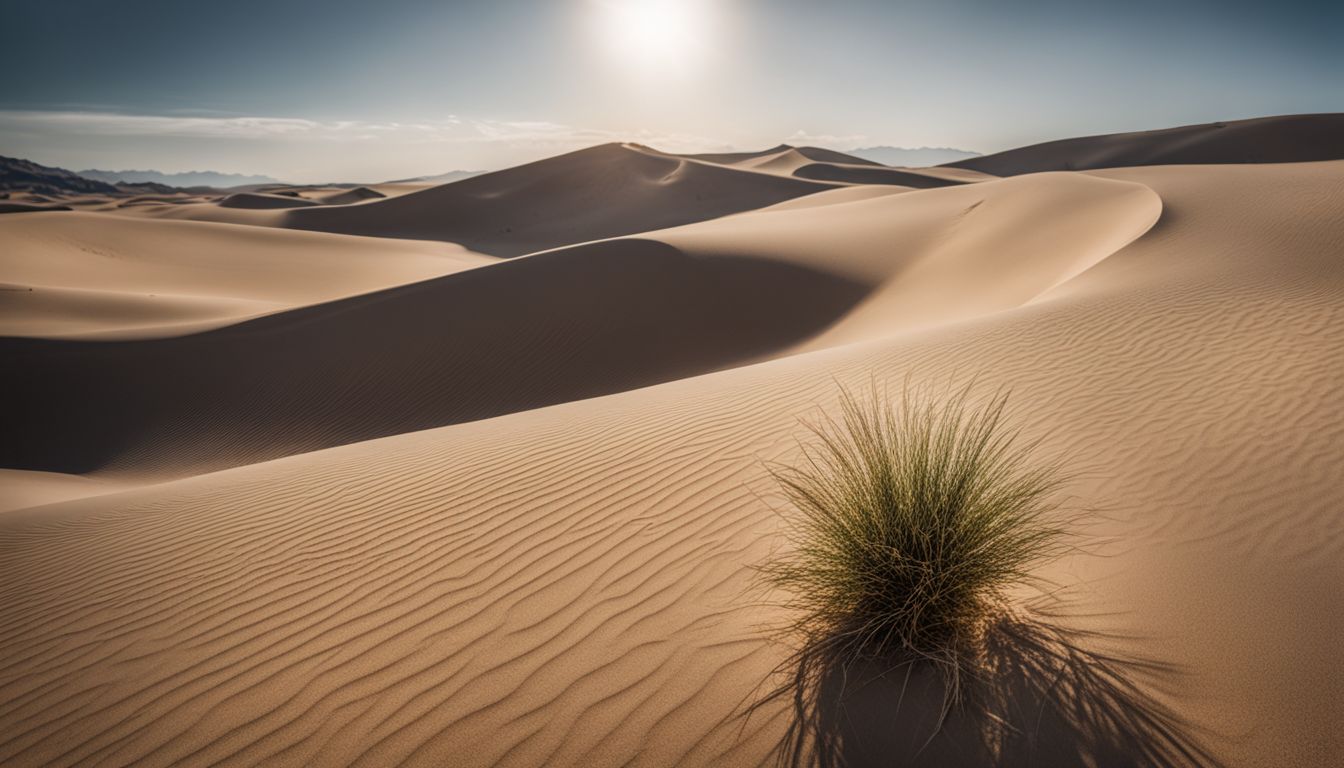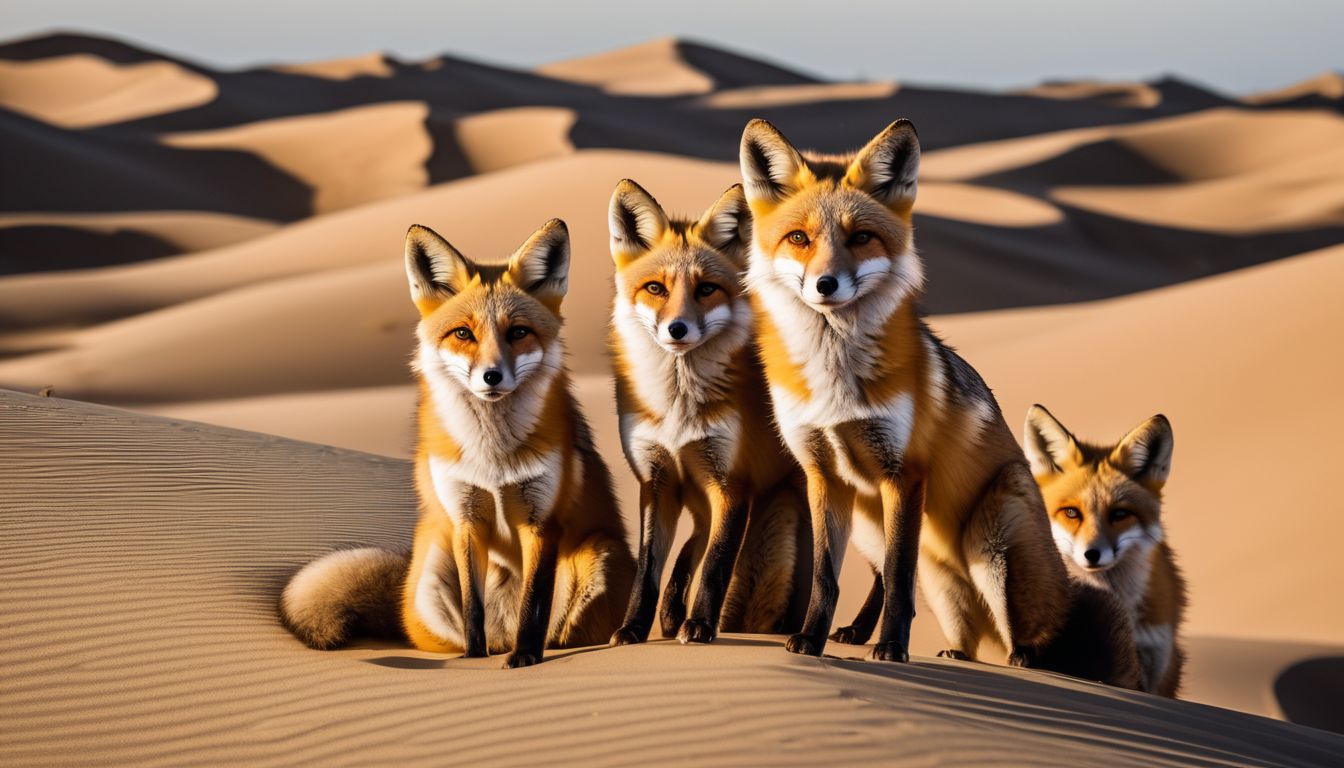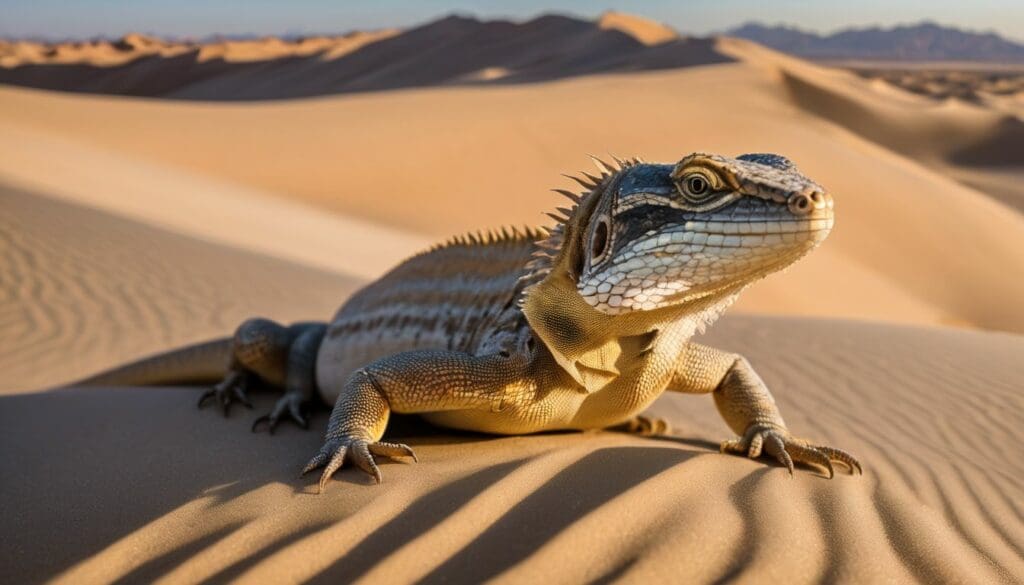Deserts present a landscape of extremes, with blistering heat by day giving way to icy chills as night falls; a true test of resilience for even the sturdiest of beings. Through meticulous exploration and research, we have peeled back the layers to unveil the remarkable survival tactics employed by denizens of these formidable terrains.
Our forthcoming article sheds light on the ingenious adaptability that allows life to persist in such stark conditions. Venture with us into this narrative and be amazed at how creatures great and small flourish on nature’s very edge.
Key Takeaways
- Desert creatures such as kangaroo rats, fennec foxes, and camels have evolved unique physiological and behavioural adaptations like efficient water conservation methods, nocturnal activity patterns, and specialised cooling systems to cope with extreme temperatures and water scarcity.
- Plants in desert environments like cacti, Joshua trees, and creosote bushes display remarkable survival strategies including water storage in thick stems, deep root systems for accessing groundwater, and CAM (Crassulacean Acid Metabolism) photosynthesis to minimise water loss.
- Microorganisms in deserts are fundamental to ecosystem health; they enrich soils by breaking down organic matter. Species such as cyanobacteria also stabilise sand dunes preventing erosion while contributing to nutrient cycles essential for plant growth.
- Desert invertebrates demonstrate incredible resilience through behaviours like the Namib Desert beetle collecting fog droplets or scorpions burrowing to escape daytime heat – all crucial for their survival within these harsh climates.
- Understanding the adaptability of life in deserts offers valuable lessons on sustainability and resource management which can guide us towards preserving biodiversity while facing global challenges like climate change.
The Challenges of Living in Desert Environments

Living in desert environments brings a host of unique challenges that we must constantly navigate. Extreme temperatures are a daily battle, with searing heat during the day plummeting to near-freezing at night.
This severe fluctuation puts immense stress on both wildlife and human bodies, demanding clever strategies for temperature regulation. The relentless sun also increases dehydration risks, making water scarcity one of the most pressing issues.
Sources like aquifers and occasional rainfalls become life-sustaining treasures that deserve our utmost respect and protection.
Finding sustenance in deserts is another significant struggle due to sparse vegetation and limited food supplies. Plants like the saguaro cactus have adapted to these harsh conditions through extraordinary means such as storing water over long periods and reducing transpiration.
Animals have evolved too; kangaroo rats exhibit remarkable drought tolerance by extracting water from seeds they eat and limiting water loss through minimal activity during the day.
We learn from these species, applying their lessons in conserving natural resources and promoting sustainable practices within our communities living amidst sand dunes and arid expanses.
Desert Mammals: Survival and Adaptation

In the searing heart of deserts, we find mammals that have masterfully honed their bodies and behaviours to thrive where others falter. Their lives are a vivid testament to nature’s ingenuity in the face of extreme aridity and scorching temperatures.
Physiological adaptations
Desert mammals amaze us with their ability to survive in harsh conditions. They’ve evolved fascinating physiological adaptations that we can learn from.
- Water conservation is crucial for desert animals. Kangaroo rats demonstrate this by producing highly concentrated urine, which reduces water loss.
- Efficient cooling systems are vital. Many desert dwellers like foxes and jackrabbits have large ears with an extensive network of blood vessels to dissipate heat.
- Body temperature regulation is a must. Some species enter a state of torpor during extreme heat to conserve energy and reduce water needs.
- Fat storage plays a significant role in survival. The camel’s hump, for instance, stores fat that can be converted to water and energy when sustenance is scarce.
- Respiratory adaptation is another key factor. Desert animals often breathe more shallowly to decrease moisture loss through respiration.
- Nocturnal activity helps avoid the daytime heat. Creatures like the fennec fox come out at night when it’s cooler, conserving precious water and energy.
- Skin and fur characteristics protect against elements. Thick skins or special fur coats help many desert animals withstand scorching sun or sandstorms.
Behavioural adaptations
Desert mammals showcase incredible behavioural adaptations to thrive in harsh climates. These creatures have evolved fascinating behaviours to conserve water and stay cool.
- Kangaroo rats emerge at night to find food, avoiding the scorching daytime temperatures which can deplete their body moisture.
- Many desert animals dig burrows or find shade during the day, creating a cooler microenvironment where they rest until dusk.
- Spadefoot toads enter a state of dormancy, burying themselves in mud for months, even years, only emerging after heavy rainfall.
- Camels conserve water by maintaining a variable body temperature that reduces the need for panting, and they store fat in their humps as an energy source.
- Fennec foxes use their large ears not just for exceptional hearing but also to disperse heat away from their bodies.
- Some birds fly vast distances to find water resources; others, like sandgrouse, absorb water with their feathers and carry it back to their chicks.
- Many reptiles actively oscillate between sunlit areas and shade to regulate their body temperature precisely throughout the day.
- Desert locusts form massive swarms that can travel great distances in search of vegetation, altering ecosystems wherever they land.
- The desert tortoise lives most of its life within a small home range, reducing energy expenditure and surviving on stored water during dry periods.
Other Desert Vertebrates: Resilience in Extreme Conditions
Venturing beyond the mammals, our journey into arid realms reveals a cast of vertebrate characters whose resilience defies the harshness of their habitat. From sculpted reptiles that dance across dunes to tenacious birds carving out existence under blistering skies, these creatures’ remarkable survival stories await your discovery.
Unique characteristics of desert vertebrates
Desert vertebrates exhibit astounding traits to thrive in their harsh habitats. These animals have honed unique adaptations that enable them to cope with extreme temperatures and scarce water.
- Water conservation is a key survival tactic for desert-dwelling reptiles. Many species, such as the chuckwalla lizard, possess highly efficient kidneys that concentrate waste, minimising water loss.
- Some desert amphibians can survive long periods of drought by burrowing underground. The spadefoot toad, for example, digs itself into the soil and enters a state of aestivation until rain returns.
- Birds in desert environments often have special behaviours to keep cool. The sandgrouse carries water back to its young in its feathers while other species fly great distances each day just to find enough food and water.
- Certain rodents demonstrate remarkable nocturnal lifestyles to avoid daytime heat. Kangaroo rats emerge at night when temperatures drop and can get moisture from seeds they eat, rarely needing to drink water.
- Thermal regulation is crucial for large mammals like camels. Their humps store fat which can be converted into water through metabolic processes while their body temperature can fluctuate to minimise sweating during the hottest parts of the day.
- Reptiles have developed varying colours and patterns on their skin not only for camouflage but also for reflecting or absorbing sunlight depending on their need to heat up or cool down.
Survival mechanisms
Living in the desert demands remarkable resilience and adaptability. We’re constantly amazed by how creatures and plants thrive under such harsh conditions.
- Kangaroo rats have evolved to almost never need to drink water; they get all the moisture they require from the seeds they eat.
- Many lizards bask in the sun to regulate their body temperature, but swiftly find shade or burrow into cool soil when it gets too hot.
- Camels store fat in their humps, which can be converted into water and energy, allowing them to go long periods without food or drink.
- Some spiders and insects use sand as camouflage, blending seamlessly with their surroundings to escape predators or ambush prey.
- Snakes often remain inactive during the hottest part of the day, becoming more active at night when temperatures drop.
- Certain plants open their stomatal pores at night instead of the day to minimise water loss while still performing necessary photosynthesis through CAM (crassulacean acid metabolism).
- Cacti have thickened fleshy parts that store large amounts of water, while spiny leaves protect them from thirsty animals.
- Birds like the sandgrouse absorb water into their feathers and fly great distances to deliver it to their chicks.
- Burrowing animals escape extreme daytime heat by digging deep tunnels where temperatures are cooler and more stable.
- To avoid dehydration, many desert dwellers reabsorb water from waste before excretion, conserving every precious drop.
- Microorganisms like cyanobacteria form cryptogamic crusts on soil surfaces, helping reduce erosion while providing nutrients for plant growth.
Desert Invertebrates: Masters of Adaptation
Desert invertebrates astonish us with their adeptness at enduring the harsh climes that would spell doom for most. These tiny yet tenacious creatures showcase a suite of ingenious strategies to not just survive, but thrive where few others can.
Notable desert invertebrates
Desert invertebrates often go unnoticed, yet they play crucial roles in the ecosystems they inhabit. They exhibit an array of fascinating adaptations that allow them to thrive in one of Earth’s harshest climates.
- Ants: These industrious insects are pivotal for nutrient cycling. They manage to locate and store food effectively, ensuring their colonies survive during times when resources are scarce.
- Scorpions: With their nocturnal habits, scorpions avoid the heat of the day by staying under rocks or burrowed in sand. Their bodies can withstand extreme temperatures, making them well-suited for desert life.
- Beetles: Many beetle species have evolved to collect and conserve water efficiently. The Namib Desert beetle gathers water droplets from fog by standing on its head – an adaptation that is as remarkable as it sounds.
- Spiders: Arachnids like the camel spider navigate desert terrains with ease. Their long legs keep them above the hot sand as they hunt for prey, showcasing a perfect blend of form and function.
- Springtails: These minute creatures engage in a process called anhydrobiosis to survive drought conditions. They can lose almost all body water and revive once moisture returns.
- Lichens: Although not strictly invertebrates, lichens are important players in deserts. They cling onto rocks, going dormant when dry and springing back to life with rainfall.
Survival strategies
Living in extreme environments demands inventive survival strategies. We’ve observed remarkable methods that desert species employ to thrive in harsh conditions.
- Animals like kangaroo rats adapt by getting moisture from seeds they eat, which reduces their need for water.
- Many desert plants, including cacti, store water in their thick stems and leaves, a trait known as succulence.
- Nocturnal lifestyles help creatures such as snakes avoid the scorching heat of the day.
- Several birds and reptiles lay eggs underground where it’s cooler and more humid, providing a safer start for their young.
- Some microorganisms, like photosynthetic bacteria, form protective cysts to survive dry spells.
- Desert amphibians often burrow into the moist earth during hot periods and rehydrate with seasonal rains.
- Creatures like springtails go into a state of stasis called cryptobiosis until better conditions return.
- Indigenous peoples have historically constructed intricate systems of water reclamation that are still studied and admired today.
Desert Plants: Flourishing Against the Odds
In the face of scorching sun and scarce water, desert plants don’t just survive—they thrive. These resilient species have honed incredible strategies to flourish where few other life forms can.
Desert plant species
Desert plants astound us with their ability to thrive under the harsh conditions of extreme heat and scarce water. These species have evolved remarkable adaptations that allow for survival in some of the most inhospitable places on Earth.
- Cacti are the quintessential desert dwellers; their thick, fleshy stems store precious water. To prevent loss through transpiration, they’ve reduced or even abandoned leaves, exposing spines instead.
- The Joshua tree, iconic of the Mojave Desert, withstands drought by storing water in its expansive root system which can extend to a depth of 30 feet.
- Creosote bushes spread wide apart from each other to minimise competition for water. Their roots form a dense network near the surface to quickly absorb moisture from rare rains.
- Mesquite trees have long taproots reaching down to groundwater sources when surface moisture is non-existent. This strategy grants them access to life-sustaining resources hidden deep beneath the soil.
- Agaves employ an efficient method known as Crassulacean Acid Metabolism (CAM) photosynthesis. They open their stomata at night to reduce water loss and store CO2 for daytime use.
- Ocotillo plants showcase long, spindly stalks covered in small, resilient leaves that appear soon after rain and drop during dry spells to conserve energy and water.
- Brittlebush survives thanks to its silver – grey leaves coated with fine hairs reflecting sunlight away and reducing heat absorption thereby lessening the need for cooling through evaporation.
Adaptation mechanisms of desert plants
Moving from the variety of species to how they cope, desert plants exhibit incredible resilience. They’ve evolved remarkable mechanisms to flourish in harsh conditions where water is scarce.
- CAM photosynthesis allows plants like cacti to open their stomata at night, reducing water loss during the hot days.
- Succulents store water in their thick, fleshy leaves and stems for use during droughts.
- Plants such as creosote bush have wax – coated leaves that reduce evaporation and protect against eroding winds.
- Perennials often grow long root systems reaching depths where moisture is more abundant.
- Many desert flora drop their leaves during dry periods to minimise water loss and survive on stored nutrients.
- Some species produce seeds that can lie dormant for years until enough rain triggers germination, ensuring species survival.
- Desert shrubs have small, tough leaves or spines which reduce sun exposure and help conserve moisture.
- Certain plants engage in allelopathy, releasing chemicals into the soil to inhibit competitors and maximise their own water uptake.
- The reflective surface of some leaves deflects sunlight, keeping the plant cool and minimising evaporation.
Microorganisms in Desert Environments: Life on a Micro Scale
In the vastness of arid lands, tiny desert microorganisms thrive against all odds. These minuscule life forms boast remarkable adaptations that allow them to not just survive, but flourish where few others can.
Various types of desert microorganisms
Desert microorganisms thrive in places you’d least expect them to. They are little known heroes, playing a crucial role in desert ecosystems.
- Blue – green algae, also known as cyanobacteria, form the base of many food chains. They’re capable of photosynthesis and can fix nitrogen from the air, enriching the soil.
- Fungi exist symbiotically with plants through mycorrhizal relationships. This helps plants absorb water and nutrients more efficiently.
- Bacteria in deserts can be extremophiles, living in conditions that would kill most organisms. Some specialise in breaking down tough plant material.
- Actinomycetes, a type of filamentous bacteria, give desert soil its distinctive earthy smell and help decompose organic matter.
- Yeasts found on cacti and other desert plants play a role in plant decay and nutrient cycling.
- The cryptoendolithic microbes live inside rocks. They survive by mining minerals and can withstand intense sunlight and dehydration.
Roles and adaptation strategies of microorganisms
Desert environments teem with invisible life – countless microorganisms play vital roles in these extreme ecosystems. They exhibit incredible strategies to survive and thrive where water is scarce.
- Microbes in desert soils break down organic matter, cycling nutrients essential for plant growth. Their activity enriches the soil, enabling hardy desert plants to flourish against the odds.
- Certain bacteria and fungi form symbiotic relationships with desert plant roots. This partnership helps plants access water and nutrients in exchange for sugars produced through photosynthesis.
- These tiny organisms demonstrate remarkable water storage capabilities. Some can absorb moisture from the air during rare rainfall events, storing it within their cells for extended periods of drought.
- Many desert microorganism species produce spores or cysts that resist dry conditions. These dormant forms can endure extreme heat and desiccation, reactivating when conditions improve.
- Microbial communities colonise beneath rock surfaces, creating a protected environment known as hypoliths. Here they carry out photosynthesis and contribute to bioweathering of rocks, slowly changing the landscape.
- In hyper – arid regions like the Sahara Desert, microorganisms survive by metabolising airborne organic materials or even hydrocarbons, showcasing flexibility in energy sources.
- Cyanobacteria present in certain deserts stabilise sand dunes with their sticky sheaths. This process helps prevent erosion while creating habitable environments for other species.
- Some extremophile microorganisms living near hot springs and hydrothermal vents rely on chemosynthesis. They convert chemicals like hydrogen sulphide into energy without sunlight.
- Desert microbes assist in breaking down pollutants, playing a crucial role in natural waste recycling processes. This function is critical around human settlements where reclaimed water systems are less effective.
- Innovative research on these desert dwellers provides insights for renewable energy production. Understanding their biochemical processes could lead us towards more sustainable energy solutions.
The Role of Microbial Communities in Desert Ecosystems
In desert ecosystems, microbial communities are unsung heroes; they shape soil health and support plant and animal life in profound ways. These tiny organisms regulate essential processes that underpin the fragile balance of life amidst scorching heat and scarce water.
Impact on soil quality
Microbial communities play a crucial role in maintaining soil quality in desert environments. These tiny organisms break down organic matter, helping to create nutrients that plants need to grow.
Their work is vital because the extreme conditions make it hard for other forms of life to survive and contribute to the nutrient cycle.
We often overlook this aspect of desert ecosystems, but without healthy soil, plant life would struggle, and the entire food web could collapse. Microbial activity affects how much water the soil can hold and its overall structure.
This process makes deserts more habitable for other species by fostering growth where it seems almost impossible.
Influence on plant and animal life
Desert ecosystems teem with life that has evolved in remarkable ways to thrive under harsh conditions. Microbial communities play a crucial role, influencing both plant and animal residents.
These tiny organisms help plants by breaking down organic material, releasing nutrients into the soil. They can even assist plants in resisting stressful desert conditions by enhancing their drought tolerance.
Animals also benefit from microbial action – some insects depend on microbes for digestion while other species use microorganisms as an integral part of their food chain. The symbiotic relationships between these diverse forms of life create a balanced environment where each organism contributes to the survival of others.
Stepping away from the microscopic world, let’s consider how humans have adapted to living in deserts, which is our next topic of discussion.
Human Life in Deserts: Ancient Cultures and Modern Challenges
Human settlements have flourished amidst the arid sands for millennia, adapting ingeniously to the harsh desert climes. Today, we’re faced with novel hurdles as we strive to sustain these time-honoured communities against the backdrop of modern environmental challenges.
Historical perspective
Historical perspective
Our ancestors settled in deserts thousands of years ago, facing scorching sun and scarce water. They ingeniously adapted to these harsh environments, developing unique cultures that thrived in places like the Gobi Desert.
We learn from their traditional knowledge, understanding how they conserved precious resources like water. Their sophisticated methods ranged from digging underground aqueducts to creating systems akin to water recycling.
As time passed, desert societies evolved with changing climates and shifting sands. Trade routes emerged across hot deserts, connecting distant communities and fostering cultural exchanges.
These historic paths remind us how resilient humans can be; despite extreme conditions, life not only persisted but often blossomed into vibrant civilisations. Today’s challenges continue to draw upon the wisdom of ancient desert dwellers as we seek sustainable ways to live within these formidable biomes.
Current challenges and solutions
Deserts face multiple challenges, but there are innovative solutions at play to tackle these issues. We’re seeking ways to live harmoniously with these stark landscapes while protecting their natural beauty.
- Water scarcity is a pressing issue in deserts. The Central Arizona Project and Salt River Project introduce canal systems that redirect water to arid regions, ensuring communities and ecosystems receive the vital resource they need.
- The survival of desert plants often depends on their ability to withstand drought. Drought – tolerant species like CAM plants have specialised methods to conserve water, which serve as models for developing sustainable agriculture in arid areas.
- Desert wildlife struggles with habitat loss due to human activities. Creating protected areas and breeding grounds helps preserve essential species, such as the kangaroo-rats unique to these environments.
- Sand encroachment threatens infrastructure and agricultural land. Planting perennial plants and using renewable energy sources for creating barriers can reduce the impact of shifting sands.
- Climate change exacerbates wildfires in dry regions. Adopting early warning systems and promoting fire-resistant construction can mitigate the risk of extensive damage.
- Soil degradation is a major concern in desert biomes. Microbial communities play a crucial role in maintaining soil health, and studying these tiny organisms provides insight into how best to manage and restore soil quality.
- Human settlements in deserts come with a range of modern challenges. Utilising technology like solar power harnesses the abundant sunlight, turning a harsh condition into an opportunity for sustainable living.
The Impact of Climate Change on Desert Environments and Dwellers
As climate change accelerates, its grip tightens on desert environments, altering ecosystems in ways that threaten both the resilient species that call these stark landscapes home and the humans who have adapted to thrive alongside them.
These shifts herald profound consequences; from dwindling water sources to shifting sand dunes, every aspect of life in arid realms is facing unprecedented challenges.
Effects on flora and fauna
Climate change hits hard on desert ecosystems, affecting both plants and animals. With rising temperatures and shifting precipitation patterns, the survival of many species hangs in the balance.
Desert flora often face increased drought stress; some may struggle to cope, whereas others might adapt by developing deeper root systems or tougher leaves to conserve water. Fauna must also adjust their behaviours – nocturnal creatures become more active during the day to avoid extreme heat, while others might migrate or hibernate to survive harsh conditions.
Deserts are home to a surprising diversity of life that has mastered the art of living with little water. Yet as climates shift, these adaptations are tested like never before. The delicate balance between these organisms and their environment is disrupted, forcing rapid changes that could lead to reduced biodiversity.
We see springtails burrowing deeper into sand for moisture or small mammals altering their diets due to scarce vegetation – every tiny alteration sends ripples through this fragile ecosystem.
Implications for human life
As desert ecosystems undergo dramatic changes, so too does our way of life in these arid regions. The shifting climate poses serious threats to agricultural practices that sustain local communities.
With annual precipitation dwindling, farmers face harsher conditions for crop production and livestock maintenance, directly impacting food security and livelihoods.
Our health also comes under threat as dust storms become more frequent, carrying pathogens and pollutants over vast distances. In areas like coastal deserts where the reliance on oceans for sustenance is high, alterations in seawater composition can affect fish populations, which many depend upon for nutrition and trade.
We’re tasked with developing innovative solutions to combat these challenges – from improving water conservation methods to harnessing renewable energy sources that are abundant in sunbaked desert landscapes.
Desert Conservation Efforts: Preserving Life in Extreme Environments
In our quest to safeguard these vast expanses of stark beauty, we champion desert conservation efforts that are crucial for the survival of unique ecosystems. We’re actively involved in pioneering initiatives and shaping future strategies, ensuring the enduring legacy of life in Earth’s most extreme habitats.
Importance of desert conservation
As lovers of Earth’s diverse landscapes, we recognise the vital role deserts play in maintaining ecological balance. They are not just barren stretches of sand; they host intricate ecosystems teeming with life that has mastered the art of desert survival.
By preserving these areas, we safeguard unique plant species that have evolved to thrive without much water and create a leaf capable of surviving scorching sun and chilly nights.
We must also champion conservation efforts because deserts serve as critical buffers against climate change. Their soils lock away carbon, helping to regulate atmospheric conditions while providing habitats for specialised microbiomes akin to deep-sea hydrothermal vents in their complexity and importance.
With every square mile lost to neglect or exploitation, our planet’s health falters. Therefore, protecting these arid regions is imperative—not only for the creatures who call them home but also for humanity’s continued wellbeing on this shared planet.
Current initiatives and future strategies
- We’re expanding protected desert areas to ensure the survival of unique ecosystems, safeguarding them from development and pollution.
- Our teams reintroduce native plant species into degraded areas, kickstarting natural recovery processes.
- We adopt renewable energy sources in nearby communities to reduce reliance on unsustainable practices harming desert habitats.
- Water conservation projects become a top priority, using technology like drip irrigation to support agriculture without depleting scarce resources.
- Engaging local communities in eco – tourism offers economic incentives while also educating visitors about the fragility of these environments.
- Cutting – edge research into desert microorganisms may unlock new ways for improving soil quality, thus benefitting both flora and fauna.
- Support for stricter anti – poaching laws ensures that rare desert mammals are not driven closer to extinction.
- Sensitisation campaigns highlight the impact of climate change on deserts, aiming to foster global action against this pressing issue.
- Collaborations with international bodies help us draw on global expertise and secure funding for long-term conservation efforts.
Conclusion
In exploring the vast expanses of deserts, we’ve uncovered a world teeming with resilience and ingenuity. Creatures great and small have mastered the art of survival in these arid lands where water is scarce, and temperatures can soar or plummet dramatically.
Plants too defy the harsh conditions, evolving remarkable strategies to thrive. Our journey through desert life reveals a stunning testament to nature’s adaptability – an inspiring reminder that life, against all odds, finds a way to endure and prosper even in the most extreme environments.
FAQs
1. What kinds of creatures live in cold deserts?
In cold deserts, you can find hardy animals like springtails that have adapted to survive the extreme conditions.
2. Are there living things at the bottom of the ocean near hydrothermal vent systems?
Yes, deep down at the bottom of the ocean water, near hydrothermal vent systems, unique species thrive in very hot and mineral-rich environments.
3. Can plants grow in subtropical desert areas?
Indeed, some plants are specially adapted to withstand the harsh climates found in subtropical areas and manage to flourish despite limited water resources.
4. Where can I learn more about life in these extreme environments?
You might watch documentaries on platforms such as Amazon Prime that explore how life adapts and thrives even in Earth’s most challenging habitats like deserts and ocean depths.





